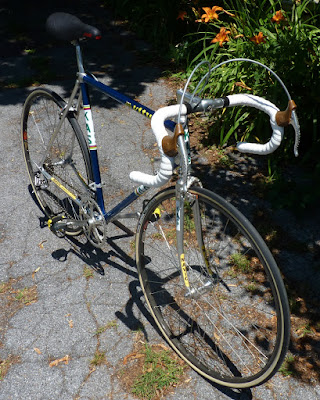...Campagnolo strikes again...and AGAIN!
I purchased a Shimano (or more accurately
called J.I.S. – Japanese Industrial Standard) compatible spindle, in order to
solve the worn Campagnolo crankset problem on Brendan’s Sean Kelly tribute
bicycle. You may recall that the square hole (which was British or I.S.O. –
International Standards Organization) had been “stretched” out of shape
When I test fit the parts, it seemed that
the more gradual taper of the Shimano part would indeed give me the needed area
onto which I could bolt the cranks. Unfortunately when I inserted the spindle
into the bottom bracket, I found that the supplier had not sent the length of
spindle I had ordered, and this one would be too short.
I had been growing impatient with the length
of time it took for this spindle to come in the mail,
and I didn’t want to wait again for the correct part to arrive. I headed over
to Bikesport (to the rescue once more!) to borrow a tool for another Campagnolo
outdated part - a Power Torque bottom bracket cap/bolt with an unusual hex key
size. While I was there I asked James, a vintage enthusiast, about my vintage
Campagnolo crankset issue.
“You might need a shim - or should I say,
make one out of a soda can,” he explained. I immediately thought of the
little-known fact that Greg Lemond’s aero bars during his 1989 Tour de France victory (you know, the one he won by 8 seconds on the final day time trial) had clamps
that were slightly too large for the handlebars. His mechanic fashioned shims
out of strips of Coke can – click on the photo to enlarge and see them.
James emphasized that I was just putting
back the metal that was stretched out of shape, and it should work fine. The
only problem was figuring out some way to keep the metal strips in place so
that they wouldn’t slide out when I tightened on the cranks. My MacGyver (TV
show character who had a knack for solving huge problems, like disarming a
bomb, with toothpicks, pocket lint, generally whatever he could find) job was
to size a strip that would wrap over two sides of the spindle end and then cut
out a hole for the crank bolt to fit through.
Flattened out, the piece kinda looked like a
Band-Aid with the gauze section cut out, and in fact, this little sliver of
ginger ale can (the green went nicely with the Irish legend’s bicycle, I
thought) did heal the bike’s boo-boo perfectly. The crankset went on tightly and
with the needed frame clearance. Brendan was very pleased with the final
results.
I was excited when the Ultra Torque bottom
bracket cups for the Ridley bicycle arrived just a couple days after I ordered them, and the remaining build went
quickly, as I assembled the cranks and fit the chain. With the derailleurs and levers
already in place, all that was left was adjusting the shifting, but my
enthusiasm was ground to an abrupt halt when I found the right-hand shifter slipping
over multiple cogs on the way down from large to small sizes. This was a sure
sign that the ratchet might be stripped.
I started to take the lever apart, as I have
rebuilt (very) early Shimano and pre-2009 Campagnolo Ergo levers, but I found
the internals on this Centaur shifter unlike others I have seen. Sadly, I found
out by looking at some online Campagnolo manuals and by consulting some online
forums regarding these shifters that they are NOT rebuildable.
Within the shifter mechanism there is a
notable inclusion of plastic gears that of course wear out, which seems to be
the issue here. Several folks have told me parts are not available, and I
searched - with no luck finding anything - to confirm this. Apparently
Campagnolo’s idea was to sell at a lower price point (by lower, I guess they mean for folks with bigger wallets than me!),
where simply replacing the whole shifter would be cheaper than the parts and
labor would cost.
 Evidence of this line of thinking is in the
recent Campy catalogs, which show complete blow-up parts diagrams for all the
higher level shifters, but for Veloce (which have the same internals as
Centaur) only the hood, body, lever and mounting bracket are shown as separate
pieces. The solution to any needed "repairs" is supposedly to purchase a complete
shifter body (photo right) for $65+, and personally I don’t find that to be an inexpensive proposition!
Evidence of this line of thinking is in the
recent Campy catalogs, which show complete blow-up parts diagrams for all the
higher level shifters, but for Veloce (which have the same internals as
Centaur) only the hood, body, lever and mounting bracket are shown as separate
pieces. The solution to any needed "repairs" is supposedly to purchase a complete
shifter body (photo right) for $65+, and personally I don’t find that to be an inexpensive proposition!
Yes, the hoods are another $25 or so, and the levers (especially if they are carbon) can be pricey, but still - doesn't it seem like you would pretty much just be buying a completely new shifter? What I’m going to do is attempt to find a
donor shifter for the couple of parts needed, or perhaps locate a cheaper
Veloce shifter body and switch out the Centaur logo-ed lever and red anodized
bolts. Yes, RED definitely seems to be the appropriate color!








No comments :
Post a Comment